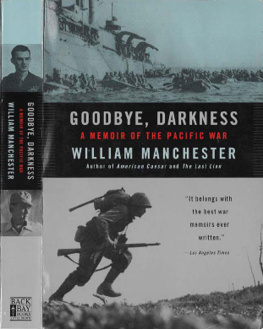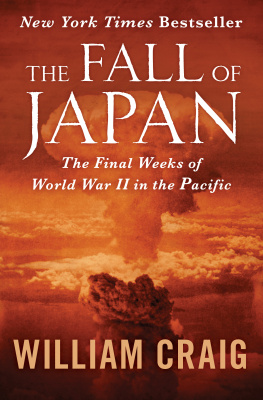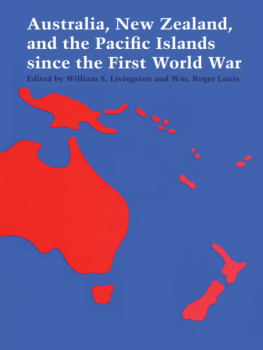NEVER LOOK BACK
A HISTORY OF WORLD WAR II IN THE PACIFIC
William A. Renzi and Mark D. Roehrs
NEVER LOOK BACK
A HISTORY OF WORLD WAR II IN THE PACIFIC
First published 1991 by M.E. Sharpe.Inc
Published 2016 by Routledge
2 Park Square, Milton Park, Abingdon, Oxon OX14 4RN
711 Third Avenue, New York, NY 10017, USA
Routledge is an imprint of the Taylor & Francis Group, an informa business
Copyright 1991 by Taylor & Francis. All rights reserved.
No part of this book may be reprinted or reproduced or utilised in any form or by any electronic, mechanical, or other means, now known or hereafter invented, including photocopying and recording, or in any information storage or retrieval system, without permission in writing from the publishers.
Notices
No responsibility is assumed by the publisher for any injury and/or damage to persons or property as a matter of products liability, negligence or otherwise, or from any use of operation of any methods, products, instructions or ideas contained in the material herein.
Practitioners and researchers must always rely on their own experience and knowledge in evaluating and using any information, methods, compounds, or experiments described herein. In using such information or methods they should be mindful of their own safety and the safety of others, including parties for whom they have a professional responsibility.
Product or corporate names may be trademarks or registered trademarks, and are used only for identification and explanation without intent to infringe.
Library of Congress Cataloging-in-Publication Data
Renzi, William A., 1941
Never look back : a history of World War II in the Pacific / by William A. Renzi and Mark D. Roehrs.
p. cm.
Includes bibliographical references and index.
ISBN 0-87332-808-6
1. World War, 1939-1945CampaignsPacific Area. I. Roehrs, Mark D., 1965-II. Title.
D767.9.R46 1991
ISBN 13: 978-0-87332-808-1 (hbk)
For Judy and David
and
In memory of Uncle Bill
Across the sea, corpses float on the water,
Across the mountain, bodies litter the fields;
I shall die in the service of my emperor,
I will never look back.
popular Japanese war song (circa 1941)
Contents
Japan Comes of AgeJapanese-American Relations after 1900Japans Growing Military Commitment in China
Yamamotos PlansAmerican Attitudes on the Eve of WarThe Attack on Pearl BeginsThe Results of the Attack
MacArthur and the PhilippinesThe War SpreadsThe Fall of the PhilippinesMore Japanese VictoriesA New Kind of War
The Doolittle RaidThe Battle of the Coral Sea and Its ConsequencesMidway
Fighting on New GuineaGuadalcanal and Related ActionsThe Japanese Are Driven from New GuineaAmerican Strength and the New Technology of WarU.S. StrategyIsland Hopping
The MarianasMacArthur Returns to the PhilippinesThe Battle of Leyte GulfThe Kamikazes Leyte and Luzon IslandsWestern Prisoners of WarThe Liberation of the Philippines
Submarine WarfareLife in JapanLife in Japans EmpireJapan Prepares for InvasionJapanese-Americans in the United States
ChinaBurmaIndia and IndonesiaThe Significance of the CBI War
Iwo JimaOkinawaThe B29LeMay and FirebombingOperation Downfall and the Atomic Bomb
The Emperor and the Japanese CabinetPeace FeelersThe Decision to SurrenderNever Look Back
This book exists for several reasons. First, the authors have devoted years to the study of the Second World War, one having had his interest in the topic begun by the late Gordon W. Prange, for whom he was graduate assistant for five years. In the last decade, moreover, a spate of fresh primary and secondary source materials has become available. As our bibliography attests, we have made liberal use of these riches, together with, of course, the best of the old, or standard, works on the topic that are likely to remain classics.
We have concentrated on the Japanese-American episodes of the conflict in The Great Pacific War (which is what the war is called in Japan) for the simple reason that they were decisive. British participation, as well as Australian and New Zealander efforts in the struggle and the China-Burma-India theater, are all dealt with, but not to the same degree. We do not mean to negate or disparage the action in these other theaters, but since the conflict was primarily a Japanese-American one, this central perspective is maintained in order to retain a balanced narrative.
The reader will remember, of course, that Japan lies across the International Date Line. Like almost all other authors, we have retained zone times (also known as local, real, or actual times) in the narrative. Thus, December 7, 1941, was December 8 in Japan, and Pearl Harbor Day, a national holiday by imperial proclamation, was celebrated on December 8 in Japan during the war years. We have not used a standard system of transliteration for Oriental names, for the simple reason that many of the actors are already well known and being doctrinaire in the matter might well be confusing; in most instances, we have employed the usual or most common transliteration for the family names involved.
We have tried to give both the Japanese and American points of view toward the conflict, in both its origins and actual conduct. The American side is relatively well known to many English-language readers; the Japanese side, perhaps less so. We have tried to keep a relatively even balance, but if we tend occasionally to explain Japanese motives and values a bit more than American ones, it is in the simple belief that they will be of greater interest to the reader.
The authors are in the debt of a fair number of people who aided them in the course of their research. Among these are Professors David Healy and David Buck, who read all or parts of this manuscript. We have profited greatly from their suggestions and criticisms. Gail Jacobsen, our departments chief secretary and an author in her own right, provided many favors, including financial assistance for the photographic work. Michael Weber, our chief editor, not only worked with us very constructively but also did a good deal of line editing himself (he wont get a chance to edit this line out). M. E. Sharpes project editor was Alexandra Koppen; the manuscript was copyedited by Bessie Blum. The United States Army, Navy, and Air Force, and the National Archives provided many of the photographs used in the text, and Patrick Steele and Jeanine Pagliaro drew the maps. Lastly, many veterans on both sides of the Pacific shared their memories with us, and we owe them a debt greater than can be stated. If their individual efforts have not been acknowledged, it is only because our debt is so great. For any errors we alone are responsible.











